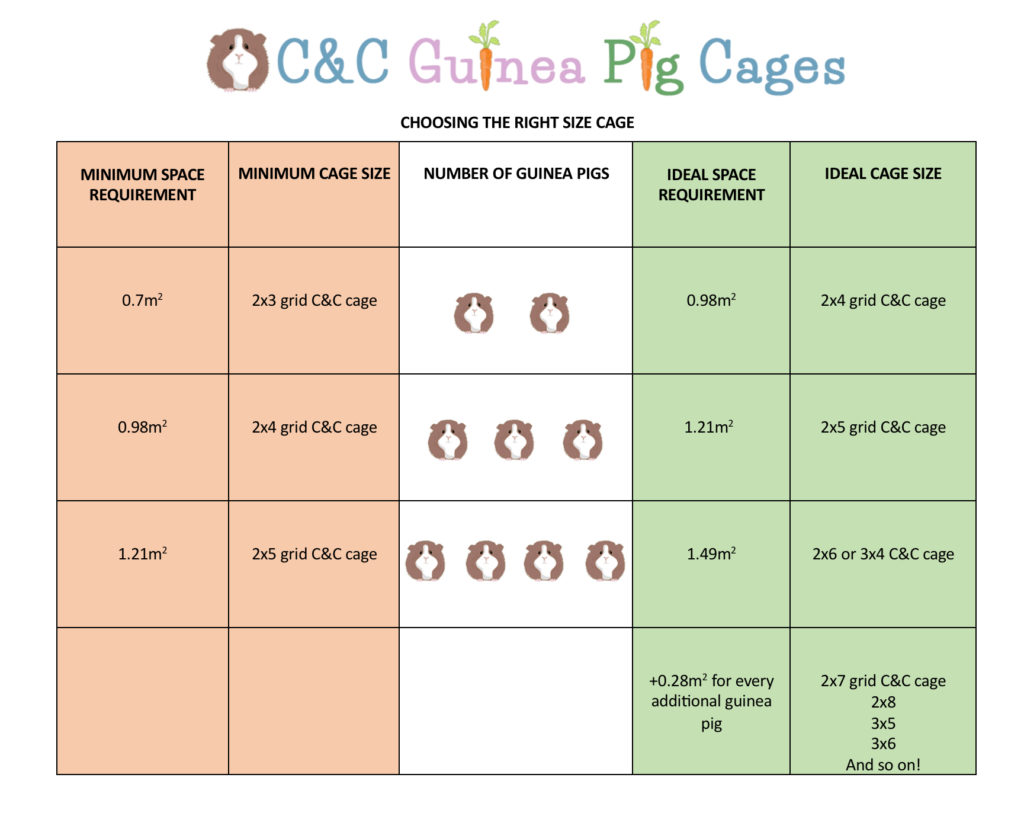How Much Space Do Guinea Pigs Need?
(For boars we’d recommend one cage size larger)
Guinea pigs are inquisitive pets known for their charming personalities and gentle nature. One of the most important aspects of caring for these furry friends is ensuring they have enough space to thrive, yet it is often overlooked. Whether you’re considering keeping them indoors or outdoors, understanding their spatial needs is essential for their health and happiness. In this blog post, we’ll explore how much space guinea pigs need, the best types of housing options available, and the benefits of C&C cages.
Understanding Guinea Pig Space Requirements
Guinea pigs are social animals that require as much space as possible to move around, explore, and interact with their environment. The general guideline is that each guinea pig should have a minimum of 7.5 square feet (0.7 square metres) of living space. However, more space is always better as it allows for more enrichment activities and helps prevent boredom and health issues.
Indoor Space Considerations
When keeping guinea pigs indoors, you have several options regarding their living arrangements. The most common indoor housing solutions include:
- Commercial Cages: Many pet stores sell cages supposedly designed for guinea pigs. While these can be convenient, most do not provide enough space for your pets to roam freely.
- C&C Cages: One of the best options for indoor housing is a C&C (Cubes and Correx) cage. These cages are modular and customisable, and can be built to fit your available space while providing plenty of room for your guinea pigs to play and explore. A typical C&C cage can easily accommodate multiple guinea pigs without feeling cramped.
- Playpens: If you want to give your guinea pigs some extra room outside their main enclosure, consider using a playpen made from modular panels or grids that can be set up in any area of your home. C&C grids can easily be tied to make a fold away play pen.
Outdoor Space Considerations
If you prefer to keep your guinea pigs outdoors, it’s crucial to ensure they have a safe and secure environment that protects them from predators and harsh weather conditions. Many rescue centres won’t rehome to outdoor environments due to the risks above.
- Outdoor Hutches: These are popular choices for outdoor living but often lack sufficient floor space unless they’re quite large. Make sure any hutch you choose has an enclosed area as well as a run attached so your pets can enjoy fresh air while having enough room to move around.
- Secure Runs: If you have an outdoor hutch, adding a secure run allows your guinea pigs to enjoy some time outside safely while giving them additional exercise space.
- Shade and Shelter: Regardless of whether they live in a hutch or a run, ensure there’s adequate shade during hot weather and protection from rain or wind.
Why Space Matters
Providing adequate space is vital for several reasons:
Physical Health
Guinea pigs need room to exercise; insufficient space can lead to obesity and related health issues such as heart disease or diabetes. A larger area encourages them to move around more freely.
Mental Well-being
Boredom can lead to stress in guinea pigs which may manifest in destructive behaviours or even depression-like symptoms. By providing ample space filled with toys, tunnels, and hiding spots within their enclosure—especially in larger setups like C&C cages—you’ll help keep their minds active.
Social Interaction
Guinea pigs are social creatures that thrive on companionship—both with humans and other guinea pigs! Having enough room allows them to interact comfortably with each other without feeling threatened or overcrowded. One of the most common causes of guinea pigs falling out is the lack of cage space provided.
Designing the Perfect Habitat
When designing an ideal habitat for your guinea pig(s), consider the following elements:
- Flooring: Ensure the flooring is comfortable; avoid wire bottoms as these can hurt their feet.
- Hideouts: Provide plenty of hiding spots where they can retreat when feeling stressed.
- Toys & Enrichment: Include chew toys, tunnels, ramps, and other forms of enrichment that encourage exploration.
- Cleaning Access: Make sure you design the habitat so it’s easy for you to clean regularly—this will help maintain good hygiene!
- Ventilation & Temperature Control: If keeping them indoors or outdoors during warmer months ensure proper ventilation so they don’t overheat; also provide warmth during colder months if necessary!
Conclusion
In conclusion, understanding how much space guinea pigs need is so important when deciding how best to care for them—whether indoors or outdoors! Providing at least 7.5 square feet per piggy along with enriching environments like C&C cages will significantly enhance both their physical health and mental well-being. Still unsure what cage size would be best? Email us at info@candccages.co.uk with the number, age and gender of your piggies for our cage recommendations.
Remember that every additional square foot counts towards creating a happier life for these adorable creatures! By taking time to set up an appropriate habitat tailored specifically towards meeting all aspects of their needs—you’ll help to ensure happier, healthier pets.
For the largest range of C&C cages available & based in the UK, please visit our website!



